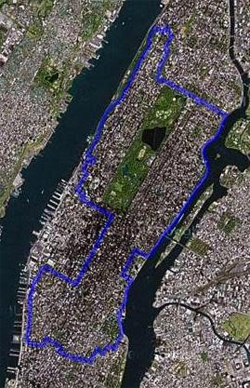A national focus will be on the Westhampton Beach election Friday when two candidates who oppose erection of an eruv Jewish religious boundary in WHB seek to join the board of trustees. NYT is AWOL on this story.
 Rubio Rubio |
Rob Rubio and Brian Tymann, who are running against incumbents Patricia DiBenedetto and Hank Tucker, said they "strongly oppose the granting of any permission for Verizon to make a licensing agreement with the East End Eruv Assn. for the erection of lechis on utility poles in WHB or for the EEEA to erect lechis on said poles."
Community acceptance is required for a valid eruv, according to Jewish law. WHB would be joining Southampton and Quogue in a battle against eruvim that started in 2008. EEEA took control of the pro-eruvim side in 2011.
Supporters of eruvim have said that blocking the boundary in the three towns would jeopardize about 70 eruvim in New York State and hundreds throughout the nation.
A victory by Rubio and Tymann would signal community opposition to an eruv.
Verizon and the EEEA, in remarks to Federal Judge Kathleen Tomlinson Feb. 24, said they sought perpetual, formal release by WHB from any opposition to an eruv in the village.
Whether WHB would grant such a request is a question that has been put to Mayor Marie Moore but has not been answered.
DiBenedetto and Tucker have not returned emails seeking their views on an eruv for WHB.
Fewer than 500 Expected to Vote
|
|
WHB has fewer than 2,000 registered voters and less than 500 often take part in an election. Marie Moore, 54, was elected mayor June 20, 2014 by a 284-187 margin over Conrad Teller, 88, who had been in office eight years.
A comparative handful of voters will thus have a major impact on an issue that roiled many communities over the years.
Key legal cases include the 2001 Tenafly, N.J., decision by Federal Judge William Bassler who said "public property should not be permanently allocated to religious purpose" and ordered an eruv dismantled.
Judge Thomas Ambro, in a 2002 Appeals Court decision, over-ruled the 2001 decision, saying Tenafly had allowed lost animal signs, house number signs, and directional signs to churches bearing crosses on utility poles, and could not therefore bar lechis.
A U.S. Court of Appeals on Jan. 6, 2015, citing the Ambro decision as well as many others, rejected claims of Jewish People Opposed to the Eruv which wanted to block erection of an eruv in WHB.
Claims of a WHB Eruv Are Disputed
 Manhattan eruv Manhattan eruv |
EEEA and Rabbi Marc Schneier of the Hampton Synagogue, who proposed an eruv for WHB in 2008, shifting the initiative to the EEEA in 2011, announced erection of the WHB eruv in August 2014.
However efforts by the Southampton Press and others have been unable to find any physical evidence of an eruv in WHB.
The website of the Hampton Synagogue says, "The Eruv Is Up."
It is depicted in a map that is on the website and may be the first all-electronic eruv.
Professor Charlotte Fonrobert of Stanford University, who specializes in Judaism, Talmudic literature and culture, authored a paper Jan. 30, 2015, that focuses on the dispute in WHB and says that online maps such as the Hampton Synagogue’s cancel claims that eruvim are "barely visible" and "unobtrusive."
Pleadings by pro-eruv groups stress that lechis are indistinguishable from other wires and plastic strips on poles and therefore the public is unaware of them.
Fonrobert wrote: "The very fact that now an eruv installation takes the form of inscriptions on maps, readily accessible online, clearly provides conceptual fodder for the perception that the Jewish community is laying claim to a geographical area of a town."
Synagogues in cities such as New York, Chicago, Skokie, and Palo Alto show their eruvim by thick lines on maps on their websites.
Where is NYT on This Story?!
We heard New York Times publisher Arthur Sulzberger and executive editor Dean Baquet proclaim for an hour and a half on June 15 that NYT covers all the news without fear or favor. The paper does not mind being second on a story as long as it gets it right, said Sulzberger.
We mark NYT AWOL on the Hamptons eruv controversy which has cost the three towns and Jewish People Opposed to the Eruv more than $1 million in outside legal costs thus far with no end in sight.
The last NYT story on this battle appeared on Feb. 4, 2013.
NYT is also ignoring a related story—the expulsion from the Rabbinical Council of America of Rabbi Schneier, who founded the Hampton Synagogue in 1990 and who initiated the move to bring an eruv to WHB.
The investigation of charges of moral improprieties by Schneier dates back to 2010 when a story in The New York Jewish Week said the RCA felt "goaded" to take action in regard to Schneier because "how would it look if we ignored this kind of behavior."
The behavior referred to was evidence that Schneier was unfaithful to his fourth wife, Tobi Rubenstein-Schneier.
"Rabbi to the Stars Caught Kissing Another Woman in Israel," headlined the Daily News Aug. 14, 2010.
Schneier told RCA he has a bipolar condition that that causes erratic behavior and that he should not be punished.
JTA Defends Expulsion
Coverage of the expulsion of the Rabbi appeared June 5 in at least three media—Jewish Forward; Jewish Telegraphic Agency, which has a worldwide circulation, and Failed Messiah.
JTA on June 15 carried a 1,223-word story with charges on both sides of the issue. RCA contradicts claims by Schneier that he was not notified of the expulsion.
"The underlying problem is that his behavior was unacceptable for a rabbi," RCA ethics chair Rabbi Shmuel Goldin told JTA.
Schneier, whose father is Rabbi Arthur Schneier of the Park East Synagogue, told JTA, "I feel betrayed. We had an agreement. We had an understanding. It was broken. I’ve been wronged. I am very, very hurt."
NYT is skipping this story even though one of its leading public affairs reporters, Nicholas Confessore, is the son of Quogue Library president Lynda Confessore.



 Husch Blackwell Strategies has added FleishmanHillard alum Michael Slatin as a principal in its public affairs group.
Husch Blackwell Strategies has added FleishmanHillard alum Michael Slatin as a principal in its public affairs group. Rory Cooper, a veteran Republican operative and policy specialist, has joined Teneo’s Washington office as senior managing director in its strategy & communications practice.
Rory Cooper, a veteran Republican operative and policy specialist, has joined Teneo’s Washington office as senior managing director in its strategy & communications practice. Brian Fallon, who served as national press secretary for Hillary Clinton’s 2016 presidential run, is signing on next month as Vice President’s Kamala Harris’ campaign communications director.
Brian Fallon, who served as national press secretary for Hillary Clinton’s 2016 presidential run, is signing on next month as Vice President’s Kamala Harris’ campaign communications director. TikTok is nothing more than a Chinese propaganda tool that poses “a grave threat to America’s national security and, in particular, impressionable children and young adults,” say two Congressmen who want the platform registered as a foreign agent.
TikTok is nothing more than a Chinese propaganda tool that poses “a grave threat to America’s national security and, in particular, impressionable children and young adults,” say two Congressmen who want the platform registered as a foreign agent. Public Strategies Washington has added Abbie Sorrendino, a former aide to now Senate Majority Leader Chuck Schumer.
Public Strategies Washington has added Abbie Sorrendino, a former aide to now Senate Majority Leader Chuck Schumer.


 Have a comment? Send it to
Have a comment? Send it to 
No comments have been submitted for this story yet.